|
|
||||
|
Published by : PROFESSIONAL MEDICAL PUBLICATIONS |
||||
|
ISSN 1681-715X |
||||
|
||||
|
- |
||||
|
ORIGINAL ARTICLE |
||||
|
- |
||||
|
Volume 25 |
April - June 2009 (Part-II) |
Number 3 |
||
|
|
||||
|
|
||||
|
|
||||
|
Published by : PROFESSIONAL MEDICAL PUBLICATIONS |
||||
|
ISSN 1681-715X |
||||
|
||||
|
- |
||||
|
ORIGINAL ARTICLE |
||||
|
- |
||||
|
Volume 25 |
April - June 2009 (Part-II) |
Number 3 |
||
|
|
||||
|
|
||||
Prevalence of EHEC 0157:H7 from human and
environmental samples from Lagos and Zaria
Smith SI1, Bello OS2, Goodluck HA3,
Omonigbehin EA4, Agbogu VN5, Odeigah P6
ABSTRACT
Objective: Prevalence, antibiotic patterns and plasmid profiles of Enterohaemorrhagic Escherichia coli (EHEC) 0157:H7 from humans and environmental sources were studied at various seasons of the year in Nigeria.
Methodology: Stool and environmental samples were obtained from Lagos and Zaria and characterized as EHEC 0157:H7 using the method of Cowan and serotyping. The isolates were further characterized using antibiotic susceptibility testing and plasmid profile.
Results: Out of 132 stool samples, 42 (31.8%) of EHEC 0157:H7 were isolated between April to December 2004. These samples were from Lagos (Western Nigeria) and Zaria (Northern Nigeria). Thirty-three isolates were from Lagos while 9 were from Zaria. Out of 90 environmental samples, 11 (12.2%) were positive for EHEC 0157:H7. The highest number of isolates (13) was obtained during the month of December, the dry, harmattan and festive season. Most of the isolates from Zaria were resistant to ampicillin, nitrofurantoin and tetracycline, while those from Lagos were resistant to ampicillin, cotrimoxazole, nitrofurantoin and tetracycline. Nine out of 53 (17%) isolates harboured detectable plasmids.
Conclusion: The presence of multi-drug resistance amongst these isolates is of concern and so antibiotic therapy should not be recommended as it complicates the disease while misuse in our environment has led to emergence of resistance strains.
KEY WORDS: EHEC 0157:H7, Plasmids, Lagos, Zaria, Antibiotic susceptibility patterns.
Pak J Med Sci April - June 2009 (Part-II) Vol. 25 No. 3 398-403
How to cite this article:
Smith SI, Bello OS, Goodluck HA, Omonigbehin EA, Agbogu VN, Odeigah P. Prevalence of EHEC 0157:H7 from human and environmental samples from Lagos and Zaria. Pak J Med Sci 2009;25(3): 398-403.
1. Smith SI,
2. Bello OS,
3. Goodluck HA,
4. Omonigbehin EA,
1,3,4: Molecular Biology and Biotechnology Division,
Nigerian Institute of Medical Research,
6-Edmond Crescent, Yaba, Lagos, Nigeria.
5. Agbogu VN,
Department of Microbiology,
Ahmadu Bello University, Zaria, Nigeria.
6. Odeigah P
2,6: Department of Cell Biology and Genetics,
University of Lagos, Nigeria.
Correspondence
Dr. SI Smith,
Email: stellaismith@yahoo.com
* Received for Publication: October 7, 2008
* Revision Received: April 23, 2009
* Revision Accepted: May 4, 2009
INTRODUCTION
Enterohaemorrhagic Escherichia coli (EHEC) 0157:H7 is a disease of public health importance. It is contacted when people get in contact with infected cattle, a popular vehicle of transmission.
1,2 It is also acquired when one eats undercooked ground beef, cider, vegetables or other products. EHEC 0157:H7 persists for long periods of time (up to 21 days) in manure, and even in soil.3 Person-to-person transmission has also been documented.4Majority of the food-borne outbreaks around the world associated with EHEC 0157:H7 involve beef.
5 Other sources of Shiga toxin Escherichia coli (STEC) are contaminated fruits and water.6,7 EHEC has been reported to persist and remain infectious for several weeks in sewage sludge, pasture land, farmyard manure and slurries.8,9The diseases caused by EHEC 0157:H7 range from mild diarrhoea to haemorrhagic colitis, haemolytic uraemic syndrome (HUS) characterized by thrombotic thrombocytopenic purpura haemolytic anaemia and kidney lesions.
10 HUS develops in about 8% of patients with the very young and elderly patients being most susceptible. HUS is also the leading cause of renal failure in children under five years.11 In the U.K. there are 4.1 cases per 100,000 in 2004, while in U.S. it is estimated to cause approximately 73,000 cases per year and 61 deaths.1 EHEC 0157:H7 are sorbitol non-fermenting microorganisms and forms the basis for their isolation.The pathogenicity of EHEC 0157:H7 depends on different virulence factors. Some of which include adherence to small bowel mucosa, direct invasion of mucosal cells, disruption of the microvillous brush border and toxin release.
12 The toxins are closely related to shiga toxin or verotoxins and damage intestinal epithelium and appear to possess neurotoxic and enterotoxic properties.12The study was aimed at studying the prevalence, antibiotic susceptibility patterns and plasmid profiles of Enterohaemorrhagic Escherichia coli (EHEC) 0157:H7 isolated from humans & environmental sources in Nigeria.
METHODOLOGY
Study area: The study area for the stool/water samples from Zaria is a suburban University settlement comprising Samaru and Jama’a in Zaria. Samaru stream discharges into the university dam which is the source of drinking water for the university community. Similarly, Kubanni River discharges into Zaria dam the source for raw water for Zaria water works. Kubanni River is largely used by local farmers for the irrigation of commercial crops and Samaru stream for recreation, bathing and herd watering. The surface waters are sources of raw water treated for drinking.
The study areas for the stool samples from Lagos are from four locations within Lagos and are mainly suburban University settlement and an urban area. The hospitals/clinics serve as referral centres for most communities and towns in Lagos and Zaria.
Sample collection: Between April and December 2004, 132 faecal specimens (94 from Lagos and 38 from Zaria) and 90 environmental samples were collected. Environmental samples were from water sources which were suspected to be contaminated with faeces were collected from River Kubanni, Samaru Stream and ABU Dam in Zaria.
Patients included children, adults and the elderly. Detailed history to define age, sex of patient and stool characteristics such as colour, texture was documented. The consistency and presence of blood or mucous or both was noted. All stool specimens were processed within two hours of collection. The samples were inoculated on sorbitol-MacConkey agar (SMAC) and observed for non-sorbitol fermenting colonies after 24 hours incubation. The isolates were then further characterized using biochemical means.
13Serotyping of EHEC 0157:H7 isolates: Suspected isolates were serotyped by slide agglutination test using anti-E.coli latex antisera (Oxoid) and the method described by Chapman.
14Susceptibility testing: This was carried out using the method of NCCLS
15 using the following antimicrobials: gentamicin, ofloxacin, augmentin, tetracycline, amoxicillin, cotrimoxazole, nitrofurantoin, cefuroxime and ciprofloxacin.Plasmid profile: This was done using the method of Birnboim and Doly.
16RESULTS
Out of 132 faecal samples, 42 (31.8%) were positive for E. coli 0157: H7, while out of 90 environmental samples, 11 (12.2%) were positive for E. coli 0157:H7. When taken separately according to states, 35% of E. coli 0157:H7 isolates were from Lagos, while
23.7% were from Zaria. The ages of the patients ranged from between 0–69 years; 30.9% were aged between 0 – 9 years, while 28.6% were between 50 – 69 years. The females comprised (69%), while the males comprised 31% (Table-I).
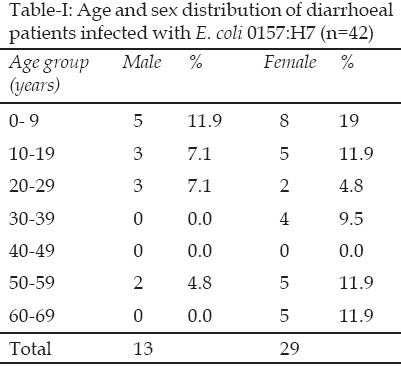
E. coli 0157:H7 were isolated almost every month from Lagos, from April – December 2004. The highest number of isolates was obtained in December,
13 while no isolate was obtained in September (Fig-1a). The isolates from Zaria showed a similar pattern with two isolates being obtained in December, others one each except September with no isolate (Fig-1b).
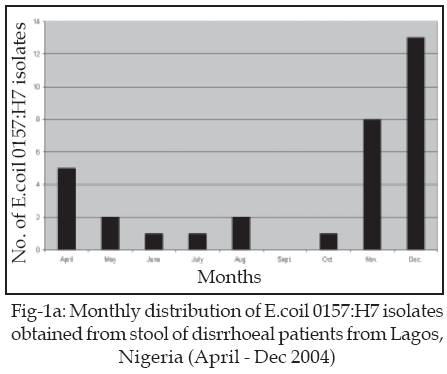
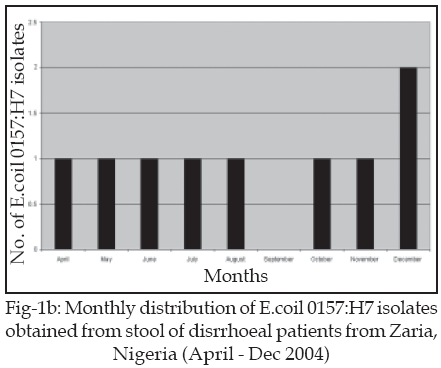
Isolates were obtained from environmental samples in Zaria only in the months of April, July, August, November and December. The months that recorded highest isolation rates of EHEC 0157:H7 were August and December (Fig-2).
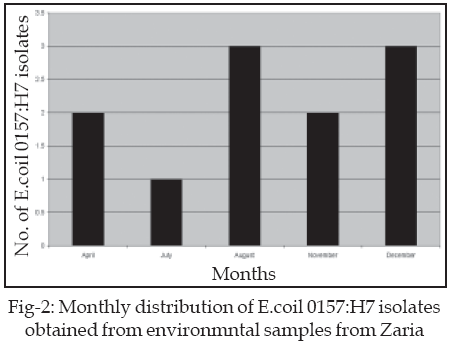
Serology: All 54 isolates were agglutinated with antisera 0157.
Antibiotic susceptibility testing: Out of 42 clinical isolates positive for EHEC 0157:H7, the resistance patterns of the isolates from Zaria showed the isolates were mainly resistant to nitrofurantoin, tetracycline and ampicillin. (Table-II), while all were sensitive to ciprofloxacin, gentamicin and norfloxacin (Table-II).
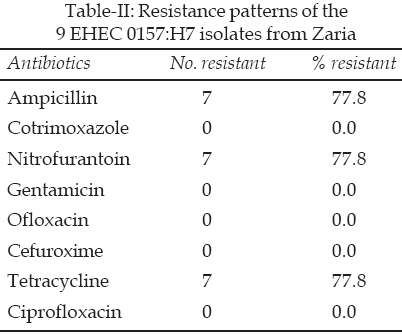
The isolates from Lagos were mainly resistant to tetracycline, ampicillin, nitrofurantoin and cotrimoxazole (Table-III). The EHEC 0157:H7 isolates from environmental samples were resistant to ampicillin, tetracycline, nalidixic acid and nitrofurantoin (Table-IV).
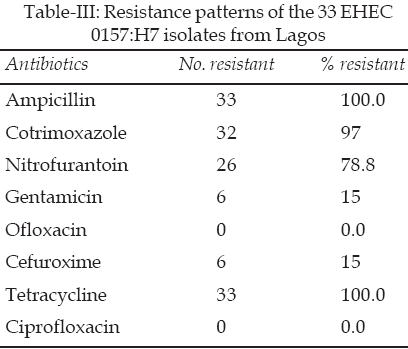
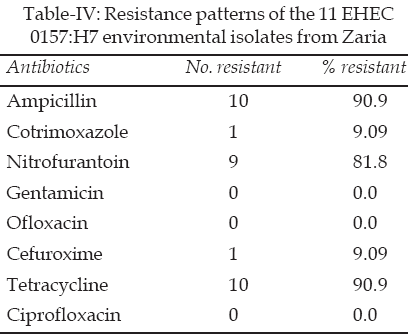
Plasmid profile: Out of a total number of 53 isolates, 9 (17%) had plasmids ranging from 20 – 100 kb.
DISCUSSION
A total of 42 (31.8%) isolates of EHEC 0157:H7 isolates were obtained from faecal samples of patients from Lagos and Zaria and this shows a significant increase in the prevalence of EHEC 0157:H7 isolates in Nigeria. Previous reports by Ogunsanya et al.,
17 and Olorunishola et al.,18 showed the prevalence in humans to be 5%. The prevalence of environmental isolates was 12.2% in this study. A comparison of the prevalence from both sites showed that Lagos had a significantly higher number and this could probably be as a result of the greater consumption of beef and presence of many eateries where meat and meat products are commonly located, although the sample size from the North was smaller. The prevalence reported in South Africa was 9%19 from clincal cases. In another report by Raji et al.,20 from Tanzania on the prevalence of EHEC 0157:H7, 10% of the isolates were positive. Interestingly in another report from South Africa the prevalence of EHEC from drinking water, meat and vegetables and stools of diarrhoeic confirmed and non-confirmed HIV/AIDS patients were studied. The following were their findings: 35.5%, 25.5%, 21.7% and 56.5% and 43.5% were isolated from meat products, water, vegetables, stools of confirmed and non-confirmed HIV/AIDS patients respectively.21 This latter study from South Africa shows a high prevalence of EHEC among HIV/AIDS patients, with our study being the next highest.Of interest also is the fact that 12.2% of EHEC 0157:H7 were obtained from water a source which indicates faecal pollution. This could be as a result of the fact that it is a common practice at Samaru village to discharge sewage directly from residential houses into gutters and drains and thus into the stream Agbogu et al.
22 It is also an area where water is used for herd watering, irrigation and recreational activities. Contamination of the environment, followed by uptake of EHEC from farm animals on pasture maintains the epidemiological cycle of EHEC and is a public health concern. In another study from South africa by Abong’o and Momba,21 the water isolates were as high as 25.5% and the authors advised that great care should be exercised to ensure that water and foods consumed by HIV/AIDS patienst are safe, as this could cause secondary infections in these patients.Our study showed that a particular human and water isolate from the same area had the same plasmid size. This is could be an indication of the fact that the EHEC 0157:H7 that infected the child could have been from the water (Fig-3).
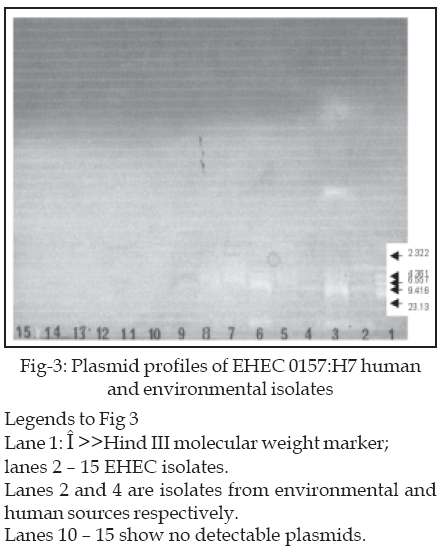
A study of the antibiotic resistance patterns of the isolates showed that generally all the isolates irrespective of site were resistant to tetracycline, ampicillin and nitrofurantoin, while the human isolates from Lagos were in addition to the above-mentioned antibiotics also resistant to cotrimoxazole. The reason for this multi-drug resistance is due to the across-the-counter purchase of drugs in Nigeria and in the case of environmental isolates, the use of antibiotics in food-producing animals to enhance growth, chemotherapy, and prophylaxis has been linked to the emergence and dissemination of antibiotic resistance genes
23 and so EHEC 0157:H7 may easily acquire drug resistance genes in its natural habitat and transfer them to other organisms of clinical relevance.Interestingly, other reports from Tanzania by Rajii et al.,
20 showed that 100% of the isolates were resistant to oxytetracycline, chloramphenicol, streptomycine and amoxyclav, while 52.6 – 92.1% of the isolates from another study in South Africa by Ateba and Bezuidenhout19 showed multiple antibiotic resistance to tetracycline, sulphamethoxazole and erythromycin. The cluster analysis of their antibiotic resistances showed that there was a relationship between isolates from the pig and human faeces rather than cattle and humans. This study did not look at animals but from our previous study24 were animals such as pigs, ram, cattle and goat were screened for the presence of EHEC 0157:H7, the goat and ram isolates shared the same plasmid profile. Although this report did not look at meat and meat products several studies have attributed the cause of food borne outbreaks to EHEC 0157:H7.19,21,25,26It is also interesting to note that although the diets of those from the North differ from the South, the resistance patterns are almost the same. This is unlike a similar study by Giammanco et al.,
27 were they observed differences in resistance patterns between strains isolated from the northern and southern Italy.The human isolates were all sensitive to the fluorquinolones. It is interesting to note that the highest number of isolates was obtained in December in both sites; this is usually a very festive period during which the dry and harmattan winds prevail. During this time also there is greater consumption of cattle, goats and chicken. It is therefore more likely to have increased the incidence of contamination by EHEC 0157:H7.
Contributions of authors to Manuscript: Dr. SI Smith made substantial contribution to the conception, design, acquisition of data and drafting, revising it critically and final approval of version to be published. Prof. P. Odeigah: substantial contribution to the conception and design and final approval of the version to be published. Mrs. HA Goodluck, Miss OS Bello, Mr. EA Omonigbehin, Mr. VN Agbogu, all made substantial contribution to acquisition of data and final approval of the version to be published.We would also like to acknowledge Mrs. MA Fowora and Miss. OC Gbodi for Technical assistance.
REFERENCES
1. Robinson SE, Wright EJ, Hart CA, Bennett M, French NP. Intermittent and persistent shedding of Escherichia coli 0157 in cohorts of naturally infected calves. J Appl Microbiol 2004;97:1045-53.
2. Crump JA, Sulka AC, Langer AJ. An outbreak of Escherichia coli 0157:H7 infections among visitors to a dairy farm. N Engl J Med 2002;347:555-60.
3. Mueller EE, Taylor MB, Grabow WOK, Ehlers MM. Isolation and characterization of Escherichia coli 0157:H7 and shiga toxin-converting bacteriophages from strains of human, bovine and porcine origin. Water Sc Tech 2002;2:29-38.
4. Chapman PA, Cerdan Malo AT, Ellin M, Ashton R, Harkin MA. Escherichia coli 0157 in cattle and sheep at slaughter, on beef and lamb carcasses and in raw beef and lamb products in South Yorkshire, UK. Int J Food Microbiol 2001;64:139-50.
5. Oldfield EC. Emerging food borne pathogens: Keeping your patients and families safe. Rev Gastroenterol Disord 2001;1:177-86.
6. Outbreak of Escherichia coli 0157:H7 and Campylobacter among attendees of the Washington County Fair-New York. Morb Mortal Wkly Rep 1999;48:803-5.
7. Hilborn ED, Mshar PA, Fiorentino TR. An outbreak of Escherichia coli 0157:H7 infections and haemolytic uraemic syndrome associated with consumption of unpasteurized apple cider. Epidemiol Infect 2000;124:31-6.
8. Duffy G. Verocytotoxigenic Escherichia coli in animal faeces, manures and slurries. J Appl Microbiol 2003;94:94S-103S.
9. Maule A. Survival of verocytotoxigenic Escherichia coli 0157:H7 in soil, water and on surfaces. Symp Ser Soc Appl Microbiol 2000;29:71S-8S.
10. Paton JC, Paton AW. Pathogenesis and diagnosis of shiga toxin-producing Escherichia coli infections. Clin Microbiol Rev 1998;11:450-79.
11. Corrigan JJ Jr., Boineau FG. Haemolytic uraemic syndrome. Paediatr Rev 2001;22:365-69.
12. Weir, E. Escherichia coli 0157:H7. CMAJ 2000;163:205.
13. Cowan ST. In: Cowan and Steel’s Manual for the identification of Medical Bacteria. 3rd Ed. Cambridge University Press, UK, 1993.
14. Chapman PA. Evaluation of commercial slide test for identifying Escherichia coli 0157:H7. J Clin Microbiol 1989;42:1109-10.
15. National Committee for Clinical Laboratory Standards. Performance standards for antimicrobial susceptibility testing. Twelfth informational supplement M100-S12. National Committee for Clinical Laboratory Standards, Wayne, Pa 2002.
16. Birnboim HC, Doly JA. A rapid alkaline extraction preocedure for screening recombinant plasmid DNA. Nucleic Acids Res 1979;7:1513-23.
17. Ogunsanya TI, Rotimi NO, Adenuga AA. A study of the aetiological agents of childhood diarrhoea in Lagos, Nigeria J Med Microbiol 1994;40:10-4.
18. Olorunshola ID, Smith SI, Coker AO. Prevalence of EHEC 0157:H7 in patients with diarrhoea in Lagos, Nigeria. APMIS 2000;108:761-3.
19. Ateba CN, Bezuidenhout CC. Characterisation of Escherichia coli 0157:H7 strains from humans, cattle and pigs in the North-West Province, South Africa. Int J Food Microbiol 2008;128:181-8.
20. Rajii MA, UM Minga RS, Machang’ U. Prevalence and characterization of verotocytoxin producing Escherichia coli 0157:H7 from diarrhea patients in Morogoro, Tanzania. Tanzan J Health Res 2008;10:151-8.
21. Abong’o BN, Momba MN. Prevalence and potential link between E. coli 0157:H7 isolated from drinking water, meat and vegetables and stools of diarrhoeic confirmed and non-confirmed HIV/AIDS patients in the Amathole District-South Africa. J Appl Microbiol 2008;105:424-31.
22. Agbogu VN, Umoh VJ, Okuofu CA, Smith SI, Ameh JB. Study of the bacteriological and physicochemical indicators of pollution of surface waters in Zaria, Nigeria. Afr J Biotech 2006;5:732-7.
23. Witte W. Medical consequences of antibiotic use in agriculture. Science 1998;279:996-7.
24. Smith SI, Aboaba OO, Odeigha P, Shodipo K, Adeyeye JA, Ibrahim A, et al. Plasmid profile of Escherichia coli 0157:H7 from apparently healthy animals. Afr J Biotech 2003;2:322-24.
25. Currie A, MacDonald J, Ellis A, Siushansian J, Chui L, Charlebois M, et al. Outbreak of Escherichia coli 0157:H7 infections associated with consumption of beef debonair. J Food Prot 2007;70:1483-8.
26. Abong’o BO, Momba MN. Prevalence and characterization of Escherichia coli 0157:H7 isolates from meat and meat products sold in Amathole District, Eastern Cape Province of South Africa. Food Microbiol 2009;26:173-6.
27. Giammanco GM, Pignato S, Grimont F. Characteristics of shiga toxin producing Escherichia coli 0157:H7 isolated in Italy and in France. J Clin Microbiol 2002;40:4619-24.
HOME | SEARCH | CURRENT ISSUE | PAST ISSUES
Professional
Medical Publications
Room No. 522, 5th Floor, Panorama Centre
Building No. 2, P.O. Box 8766, Saddar, Karachi - Pakistan.
Phones : 5688791, 5689285 Fax : 5689860
pjms@pjms.com.pk